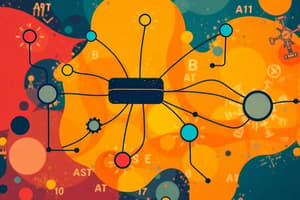Podcast
Questions and Answers
What does latency refer to in networking?
What does latency refer to in networking?
- The process of converting signals for transmission.
- The maximum capacity of a data transfer link.
- The actual rate of successful data transfer.
- The time taken for a data packet to travel from source to destination. (correct)
Which device is used to extend the range of a network by strengthening signals?
Which device is used to extend the range of a network by strengthening signals?
- Router
- Switch
- Repeater (correct)
- Gateway
Which technology allows for the management of network services through abstraction?
Which technology allows for the management of network services through abstraction?
- Network Function Virtualization (NFV)
- Software-Defined Networking (SDN) (correct)
- Modem
- 5G Technology
What is a significant drawback of throughput compared to bandwidth?
What is a significant drawback of throughput compared to bandwidth?
What does IoT stand for in networking terms?
What does IoT stand for in networking terms?
What is the primary characteristic of a Local Area Network (LAN)?
What is the primary characteristic of a Local Area Network (LAN)?
Which network topology connects all nodes to a central hub?
Which network topology connects all nodes to a central hub?
What is the role of a router in a network?
What is the role of a router in a network?
Which of the following is primarily used for sending emails?
Which of the following is primarily used for sending emails?
What does encryption do in network security?
What does encryption do in network security?
Which type of network connects devices within a very small area, such as personal gadgets?
Which type of network connects devices within a very small area, such as personal gadgets?
What is a function of the Network Interface Card (NIC)?
What is a function of the Network Interface Card (NIC)?
What is a characteristic of a Virtual Private Network (VPN)?
What is a characteristic of a Virtual Private Network (VPN)?
Study Notes
Definition
- A network is a collection of interconnected devices that communicate and share resources.
Types of Networks
-
Local Area Network (LAN)
- Covers a small geographic area (e.g., home, office).
- High speed, low latency.
-
Wide Area Network (WAN)
- Covers large geographic areas (e.g., cities, countries).
- Lower speeds, higher latency compared to LAN.
-
Metropolitan Area Network (MAN)
- Spans a city or a large campus.
- Connects multiple LANs within the area.
-
Personal Area Network (PAN)
- Small network for personal devices (e.g., Bluetooth connections).
-
Virtual Private Network (VPN)
- Secure connection over a public network.
- Used for secure data transmission and privacy.
Key Components
-
Nodes
- Devices connected to the network (computers, printers, servers).
-
Network Interface Card (NIC)
- Hardware that allows devices to connect to the network.
-
Router
- Routes data between different networks.
-
Switch
- Connects devices within the same network and filters traffic.
-
Access Point
- Allows wireless devices to connect to a wired network.
-
Cabling
- Physical medium (e.g., Ethernet cables) used for wired connections.
Network Protocols
-
TCP/IP (Transmission Control Protocol/Internet Protocol)
- Fundamental communication protocol for the Internet.
-
HTTP/HTTPS (HyperText Transfer Protocol/Secure)
- Protocol for transferring web pages.
-
FTP (File Transfer Protocol)
- Protocol for transferring files between devices.
-
SMTP (Simple Mail Transfer Protocol)
- Protocol used for sending emails.
Security Considerations
-
Firewall
- A network security system that monitors incoming and outgoing traffic.
-
Encryption
- Protects data by converting it into a secure format.
-
Authentication
- Verifying the identity of users and devices before granting access.
-
Intrusion Detection Systems (IDS)
- Tools for monitoring network traffic for suspicious activities.
Network Topologies
-
Star
- All nodes connected to a central hub.
-
Bus
- All devices share a single communication line.
-
Ring
- Each device connects to two others, forming a ring.
-
Mesh
- Every device connects to every other device, providing multiple pathways.
-
Hybrid
- Combination of different topologies.
Performance Metrics
-
Bandwidth
- Amount of data that can be transmitted in a given time.
-
Latency
- Time taken for a data packet to travel from source to destination.
-
Throughput
- Actual rate of successful data transfer, often lower than bandwidth due to various factors.
Common Networking Devices
-
Modem
- Modulates and demodulates signals for Internet connectivity.
-
Repeater
- Strengthens signals over long distances to extend network reach.
-
Bridge
- Connects different network segments, filtering traffic to reduce collisions.
Future Trends
-
5G Technology
- Provides faster data speeds and lower latency for mobile and IoT devices.
-
Software-Defined Networking (SDN)
- Allows network administrators to manage network services through abstraction.
-
Network Function Virtualization (NFV)
- Virtualizes network services traditionally run on hardware.
-
IoT (Internet of Things)
- Increasing interconnectivity of everyday devices.
Networks
- A network is a group of interconnected devices that communicate and share resources.
Network Types
- Local Area Network (LAN): Covers a small area (e.g., home, office), offers high speed and low latency.
- Wide Area Network (WAN): Spans large geographic areas (e.g., cities, countries), slower speeds and higher latency than LANs.
- Metropolitan Area Network (MAN): Connects multiple LANs within a city or large campus.
- Personal Area Network (PAN): A small network for personal devices (e.g., Bluetooth connections).
- Virtual Private Network (VPN): Creates a secure connection over a public network for secure data transmission and privacy.
Key Network Components
- Nodes: Devices connected to the network (e.g., computers, printers, servers).
- Network Interface Card (NIC): Hardware that allows devices to connect to a network.
- Router: Routes data between different networks.
- Switch: Connects devices within the same network and filters traffic.
- Access Point: Allows wireless devices to connect to a wired network.
- Cabling: Physical medium (e.g., Ethernet cables) for wired connections.
Network Protocols
- TCP/IP (Transmission Control Protocol/Internet Protocol): The fundamental communication protocol for the internet.
- HTTP/HTTPS (HyperText Transfer Protocol/Secure): Used for transferring web pages.
- FTP (File Transfer Protocol): Transfers files between devices.
- SMTP (Simple Mail Transfer Protocol): Protocol for sending emails.
Network Security
- Firewall: Monitors incoming and outgoing traffic to protect networks.
- Encryption: Protects data by converting it into a secure format.
- Authentication: Verifies the identity of users and devices before granting access.
- Intrusion Detection Systems (IDS): Detect suspicious activities on the network.
Network Topologies
- Star: All nodes connect to a central hub.
- Bus: All devices share a single communication line.
- Ring: Each device connects to two others, forming a ring shape.
- Mesh: Every device connects to every other device, providing redundancy.
- Hybrid: Combines different topologies.
Network Performance Metrics
- Bandwidth: The amount of data transmitted over a given period.
- Latency: The time taken for a data packet to travel from its source to its destination.
- Throughput: The actual rate of successful data transfer, often lower than bandwidth.
Common Networking Devices
- Modem: Modulates and demodulates signals for internet connectivity.
- Repeater: Strengthens signals over long distances to extend network reach.
- Bridge: Connects network segments, filtering traffic to reduce collisions.
Future Trends in Networking
- 5G Technology: Provides faster data speeds and lower latency for mobile and IoT devices.
- Software-Defined Networking (SDN): Allows network administrators to manage network services through abstraction.
- Network Function Virtualization (NFV): Virtualizes network services traditionally run on hardware.
- Internet of Things (IoT): Increasing interconnectivity of everyday devices.
Studying That Suits You
Use AI to generate personalized quizzes and flashcards to suit your learning preferences.
Description
This quiz covers the different types of networks including LAN, WAN, MAN, PAN, and VPN. It also examines key components like nodes, NICs, and routers. Test your knowledge on how these networks operate and their specific characteristics.




